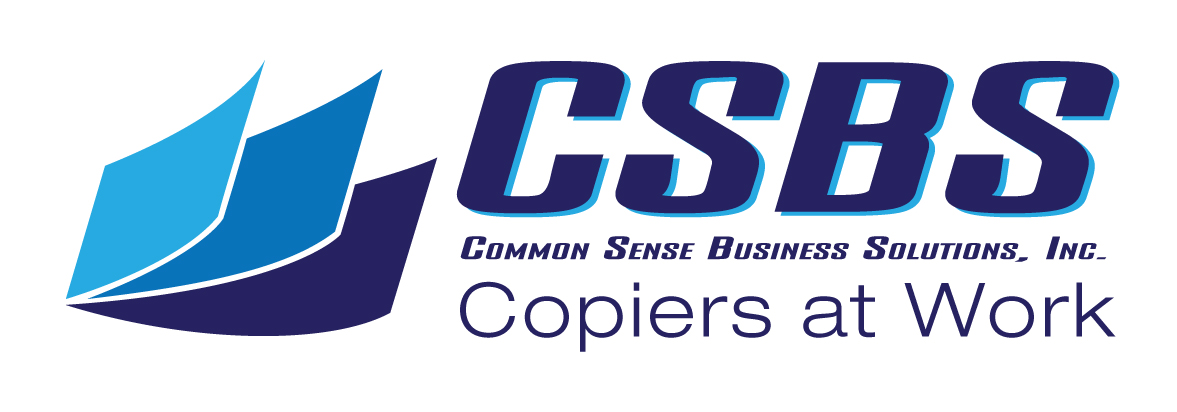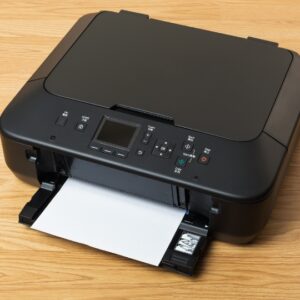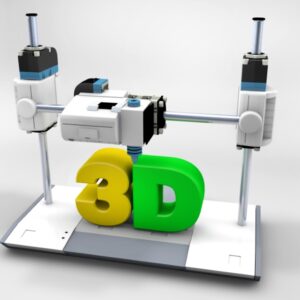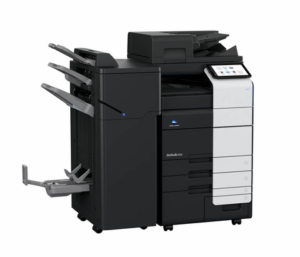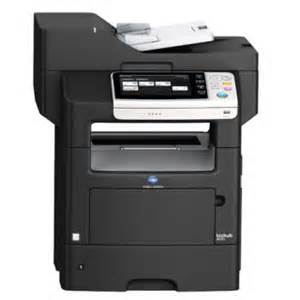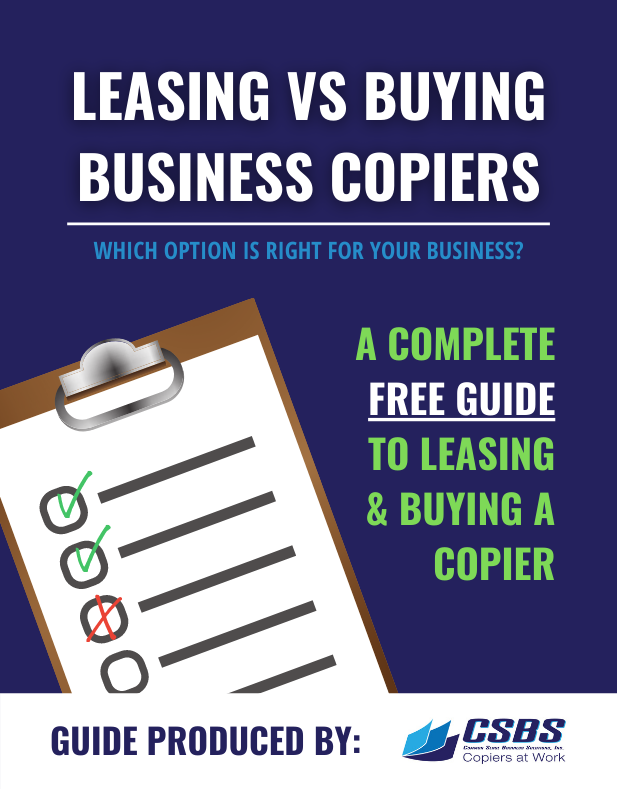What Is A Business Copier Machine?
The lowly office copier is actually a remarkable feat of engineering and science, allowing businesses to not only move away from centralized records and filing systems but to seamlessly and efficiently navigate corporate correspondence with ease.
Copy machines for business took hold in the early 1960s with the development of Xerography, a dry process that uses electrostatic charges on a light-sensitive photoreceptor to first attract and then transfer toner particles (a powder) onto paper in the form of an image. The toner is then fused onto the paper using heat, pressure, or a combination of both. Invented in 1938 by Chester Carlson, the process has since grown into a vital component of day-to-day efficiency.
But with that growth came change, and as the machines evolved, they branched into a wide variety of devices and components to suit various needs. In today’s world, it can be confusing when you are deciding which copy machine lease or purchase is right for your business.
Let’s take a look at some of the differences between copy machines for business.
First, let’s address the confusion between business copiers and printers. Although the words are often used interchangeably, there are significant differences.
| COPIERS VS PRINTERS | ||
| Copiers are FAST! | Printers are FLEXIBLE! | |
| Copiers are built for mass production. | Printers are built for high-quality imaging | |
| Copiers are more expensive to buy than printers, so make a good lease option | Printers are less expensive to buy but come with LOTS of extras, making leasing attractive here as well. | |
| Copiers have long lifespans, and tech changes slowly | Print technology evolves rapidly, offering new toners, finishes, and features | |
| Copiers are limited to the papers types, weights, & sizes it can accept | Printers accept a wide range of substrates, card stocks, unique toners, in-line finishing and a lot more | |
| Copiers have a hard drive, which must be secured if the data is critical | While Printers do have a hard drive, files sent for print are held in the RIP (Rasterized Image Processor) and can be easily secured or auto-deleted. | |
| Copiers are often standalone, and do not require, but can often accept a network | Printers can be networked and controlled using SSO (Single Sign On), access tracked, billed individually, and more. | |
| Copiers are built for speed, and can produce a large volume of copies quickly. | Printers offer a great deal of features, including imposition, numbering, file management, and more, at the cost of speed. | |
| Toner cartridges for copiers are smaller, must be changed more often, and are limited to black, or CMYK (Cyan. Magenta, Yellow & blacK) | Printer cartridges are usually larger, and longer lasting. There are specialty toners, like UV, or high gloss, that are available for many of the higher-end printers. | |
| MULTIFUNCTION COPIERS | ||
| Also known as all-in-one, or small business copiers, they combine the speed, fax, and scanning abilities of copiers with the flexibility, intelligence, and finishing options of a printer; like heavier paper, multifeeds, hole punching, booklet binding, and even spiral binding. Also, multifunction copiers can print from the network, or USB drives, or even the Internet. | ||
It is obvious why multifunction copier usage is up 1.7% since last year, and is poised to hit 1.35 billion in 2023, they have become almost required in today’s business world.
Speed, flexibility, and utility mean that there is certainly a Konica Minolta Business Solution that will fit your business copier requirements. When you need a small business copier lease consider all your options.
Let’s take a quick look at the various types of copiers & printers in common business use today.
Different Types Of Business Copier Machines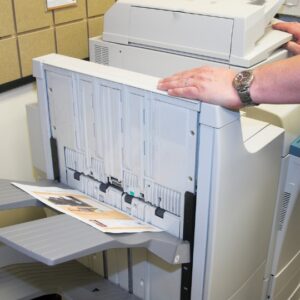
Laser Copiers
The laser copier was developed by Xerox in the 1960s. Laser printers are still widely used in large offices as they are traditionally more cost-efficient than inkjet printers.
Advantages:
- More cost-effective than inkjet printers
- Increased productivity
- High print speed
- Higher paper capacity
- Often expandable with Paper Trays, finishers etc.
- Grows with your business
Disadvantages:
- May require short ‘warm-up times’
- Larger footprint
Business Inkjet Copiers & Printers
Utilizing inkjet technology on a large scale to accommodate the needs of a busy office with heavy reliance on printed output, inkjet printers are enduringly popular due to their reliability and robust nature.
Advantages:
- Capable of producing highly detailed and photo-realistic prints
- Limited warm-up time required
- Small footprint
Disadvantages:
- Higher cost-per-page than most laser printers
- Wet prints
- Can be less reliable than laser printers
Home Inkjet Printers
Combining the technology of inkjet printing with the functionality of a multifunction printer: all-in-one inkjet printers are capable of providing full service to a busy office environment yet retain the high-quality prints that inkjet is known for.
Advantages:
- High-quality printed output
- Cost efficient and compact alternative to buying numerous machines
- Power efficient
Disadvantages:
- Wet prints
- High running costs
- Unshareable, difficult to network
Multifunction Printers and Copiers
Sometimes known as all-in-one printers, multifunction copiers are often capable of performing printing, copying, scanning, and faxing tasks. This can simplify the completion of multiple tasks within an office or domestic environment, with no need for more than one unit.
Advantages:
- More cost-efficient than buying multiple devices
- More compact than buying multiple devices
- Perform numerous tasks simultaneously
- More power efficient than the implementation of numerous devices
Disadvantages:
- Can restrict usage time available for larger workgroups.
3D Printers
One of the most exciting developments in printing technology history, 3D printing is becoming more affordable for professional and domestic users. Modern 3D printers are capable of producing 3D objects and items using different types of high-quality resin.
Advantages:
- 3D printed items
- Limitless possibilities
- Capacity for full customization
Disadvantages:
- High initial costs
- High resin costs
- Still developing technology
Wide Format
Normally found in the marketing, education, and architectural markets, wide format printers are increasingly being used for the printing of larger format work, for presentations, trade shows, and quick signage.
Advantages:
- Capable of producing highly detailed and photo-realistic prints
- Limitless possibilities
- Comparable costs to digital print
Disadvantages:
- Inkjet & Toner variants offer similar features, but differ in many ways
- Take up space
- Occasional use prevents ROI, must be run frequently to be cost effective
Applications and Uses of Business Copiers
Black & White Multifunction copiers consolidate the functionality of a printer, copier, scanner and/or FAX. Output ranges from 22ppm (Pages per Minute) all the way up to 95 ppm or more, with a capacity of over 6,000 sheets of paper, collation, inserting, sorting, and more. Compact models are also available.
- Correspondence, both internal & external
- Scanning of paper docs for digital storage
- Pamphlets, flyers, signage, standard business documents, etc.
Color Multifunction copiers offer comparable speeds, but also provide vibrant colors, some models offer additional features like auto-skew correction, color balancing, and more.
- Posters, sales materials, graphics, reports, charts, presentations, etc.
- Color correction of scans and/or image correction automatically
- Unique items, photos, letterhead, cards, specialty stocks
Wide Format Copiers offer many of the same features as their smaller counterparts, come in both color and B&W versions, but can handle larger and heavier stock sizes, allowing you to choose between roll-fed or sheet-fed, even canvas, PVC, and some plasticine fabrics like automotive shrink wrap.
- Roll-fed stock allows for very large banner printing
- Capable of excellent detail, suitable for both architectural and artistic work
- Window clings, or images on glass, wood, foam, or other substrates
3D Printers are rapidly gaining hold in the world of business, constructing three-dimensional forms from resin, or other materials. We are only just beginning to discover the many ways 3D printing will assist our business efforts.
- Creating prototypes, models, samples, and design iterations.
- Unique marketing elements and giveaways
- Low volume manufacturing
- Creation of mechanical repair parts
Considerations When Buying or Leasing a Business Copier
Sometimes it can be challenging to know which of the many copy machines for business are best suited to your unique business needs.
Color or Black & White? What speed do you need? How much processing power do you need? What kind of additional feature sets work best for you? How about bindery and finishing options? Is space a consideration? Is printing green important to you? Should you get one big one, or several smaller ones?
Each of these adds complexity to the question, so it is best to sit and talk with someone who knows your business, is local, and can help guide you through the many options available.
Maintenance & Troubleshooting Tips For A Business Copier
Leasing or buying a multifunction copier, or a wide-format printer, is a big investment, and in order to protect it, you take care of it. Basic daily care and maintenance includes proper paper storage, scanner glass care, careful removal of paper jams, and proper storage & handling of toners.
Having a service contract as part of your lease or rental agreement is vital. Having such an agreement with someone who is local and accountable is worth its weight in gold when you need your digital copier or printer to work when you need it most.
Conclusions
A loyal workhorse, your small business copier or multifunction printer will give years of service, an integral part of your business success. Asking the right questions will help you to find the right business copier and optional features for your specific business needs.
Here at CSBS, we have years of experience and have watched these technologies grow. We care about our neighbors and are proud to help them grow as well. We can help you too.
